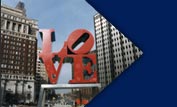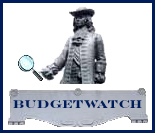- Home
- About
- News
- Tax Reform
- Ethics Reform
- Budget Reform
- Reformer’s Roundtable
- Contact Us







Tracking Tax Revenues As They Come Down The Homestretch
 BUDGETWATCHERS spend the year paying attention to tax revenues and as the budget year reaches its three-quarter turn, we can make some observations about city tax revenues and whether they will exceed or fall short of current estimations. Each year, the city administration establishes a budget for the fiscal year that is adopted to run from July 1 to June 30. Then, about midway through that fiscal year, administration officials revise those revenue estimates to help inform city leaders as they put together the next year’s budget. Looking at tax revenues today, it appears as if, despite tax-rate cuts and general economic woes, Philadelphia will continue to enjoy increased tax revenues. The city will likely finish the current fiscal year ahead of original budget estimates (made last spring) and just about where city officials estimated this past winter.
BUDGETWATCHERS spend the year paying attention to tax revenues and as the budget year reaches its three-quarter turn, we can make some observations about city tax revenues and whether they will exceed or fall short of current estimations. Each year, the city administration establishes a budget for the fiscal year that is adopted to run from July 1 to June 30. Then, about midway through that fiscal year, administration officials revise those revenue estimates to help inform city leaders as they put together the next year’s budget. Looking at tax revenues today, it appears as if, despite tax-rate cuts and general economic woes, Philadelphia will continue to enjoy increased tax revenues. The city will likely finish the current fiscal year ahead of original budget estimates (made last spring) and just about where city officials estimated this past winter.
The City of Philadelphia’s (current) Fiscal Year 2008 budget called for the city to raise more than $2.41 billion in generated taxes. Revised estimates predict that the city will bring in more than $2.45 billion in tax revenues. Based on tax revenue trends and collections from recent years, we can now make some informed tax-revenue projections.
The Wage Tax brings in nearly half of all locally generated taxes so it is a very important revenue stream for the budget. Because the tax is deducted from pay checks of Philadelphians and those employed in Philadelphia, it is possible to monitor collections throughout the year, which helps BUDGETWATCHERS monitor the fiscal state of the city. To date, Wage Tax collections have been strong, with growth of nearly 4.0 percent over last year. With only three months left in the fiscal year, Wage Tax collections project to be approximately $25 million higher than budgeted; darn close to the current estimate of $1.217 billion.
The Business Privilege Tax accounts for about 18 percent of city tax revenues. Unlike the Wage Tax revenues, which can be tracked throughout the year, most BPT revenues arrive just after tax day so the tax defies prediction. Because the tax is actually two separate levies (a tax on gross receipts and a tax on net income), one can use Sales Tax data (discussed below) to help estimate gross receipts, but estimates about business net income tend to be more of a guessing game than a scientific estimate. Despite fears of recession, Sales Tax revenues are up this year, which suggests that Gross Receipts Tax revenues would be up; and with Wage Tax revenues running ahead of last year, there is no sign that Net Income Tax revenues should dip. All that said, the city first budgeted for BPT revenues to drop from $436 million last year to $410 million this year, but then revised the estimate to be $438 this year, which may be a good guess for this notoriously hard-to-gauge tax.
By contrast, the Real Estate Tax, which brings in about 16 percent of tax revenues, is much easier to estimate. As the only tax where the city starts the tax year with a firm idea of how much is owed (the city sends out the bills based on the city’s own estimate of property values), the only question is how much will actually be collected. Despite reassessments that increased property values for tax purposes across the city, the budget and current estimate for the Real Estate Tax are little changed from last year’s collection amount of $398 million because the increase in value is offset by a change where the city will give 60 percent of total Real Estate Tax collections to the School District, which is an increase from last year when the District only received about 57 percent.
The biggest reason for concern when it comes to tax revenues is the city’s Real Property Transfer Tax, which has seen increased collections with the growth in the real estate market in recent years, but has succumbed to the market’s general cooling off. The city generates about 9.0 percent of total locally generated tax revenues from the levy, which brought in $217 million last year. In the budget and revised estimate, the city projected its decline and based on monthly collections to date, the tax will likely generate only $187 million, $30 million less than budgeted and $10 million less than estimated.
The Sales Tax, which generates more than 5.0 percent of tax revenues, has fared better. Budgeted to generate $138 million, but later estimated to bring in $136 million, the tax has maintained slow but steady growth of about 2.5 percent throughout the year and should come in at about $137, slightly higher than estimated.
Collections for the city’s other taxes (the Parking Tax, Amusement Tax, Valet Parking Tax, and Outdoor Advertising Tax) together generate less than 4.0 percent of total tax revenues. With Phillies tickets going fast and the Flyers and Sixers returning to the playoffs, the Amusement Tax and Parking Tax should get a sports-fan-aided boost. But even with this strong rooting interest, these taxes together will likely only exceed estimated amounts by about $1 million.
So despite recessionary fears, bursting real estate bubbles, and continued tax-rate reductions, total tax collections in Philadelphia continue to grow on a year-to-year basis. In fact, based on collections to date, tax revenues are likely to exceed budgeted estimates and meet current estimates. All this is fairly good fiscal news as City Council and the Mayor debate the next city budget.
